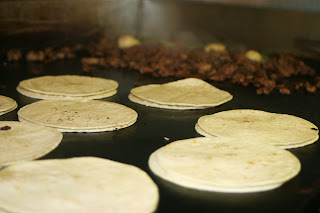Pedro García
was a supervisor in a Californian
metallurgy business for 17 years, but he decided to forge a new direction: open
his own business and change his zip code.
Five years
later and 1,400 miles away from the West Coast, he says that decision “is one
of the best things I have done in my life. Tulsa
Now, at age 47
“but with the energy of a 20-year-old,” García has two mobile taco stands: one in
east Tulsa and another in Broken Arrow
Starting was
not easy, he said. “But if you want to succeed, you have to be prepared for
everything, for bad moments and very bad ones,” García said. “Many people told me I would not
make it. Today they are my best customers.”
Two years
after opening his first stand, García acquired a second one. “A bit bigger,”
he said. “But it was a mess. I paid in installments. And now I have to have
security guards at night to maintain order and prevent chaos in the traffic
because of the cars due to all the people who come to eat.”
Garcia’s menu
remains the same as when he began, but now it is printed and translated into
English. “But they are
still the same tacos with homemade flavor,” he says, listing off by memory the
different meats, including buche(esophagus),
asada, tongue, barbecue, sausage, pastor,
carnitas, head, and suadero (brisket). “Tacos are everywhere, but
these have ingredients that you cannot find anywhere else. But the most
important thing is consistency. My tacos taste the same at any time and on any
day. If you come by or call, you know that you will eat a good product.”
During the
Cinco de Mayo Festival, which was organized by a group of Hispanic
businesspeople in east Tulsa
García said that by mid-day on the second
day, he had served more than 3,000 orders of salsa that go along with each
plate of tacos. “At that point I stopped counting, and we had no time to keep
track, but had to help keep the line moving, and, of course, be ready when the
judges showed up.”
García employs 12 Hispanic cooks working at
the two food stands, and they show up to work as if it were a franchise –
wearing colorful T-shirts that vary depending on the day of the week. “Marisol
Jiménez has been an important part of this success,” he said, referring to the
person who has perfected the recipe for the asada tacos.
That taco has
three times more meat than a regular one, pickled carrots – “but real ones, not
out of a can; we cut them here and make a homemade marinade,” said García. It also has sautéed onions,
scallions and a chile toreado (grilled jalapeño) “made at the
moment, hot off the grill.” It is served with two slices of lemon and two of
his original sauces, a red one that “makes one cry” and a green one that “is
milder.”
That taco,
says García, “is a full meal,
although sometimes you want to eat one after another.”
For now, García dreams of filling Tulsa
The
Taco King’s salsa
Through
his roots of his native Zacatecas, Mexico, García modified his hot sauce until
he found the right formula. “It was trial and error,” he said. “My customers
would tell me what they thought, until finally I succeeded. And I have two; one
is very spicy, and if someone says that it does not burn, well, they’re lying.”
Photos by Juan Miret




No comments:
Post a Comment